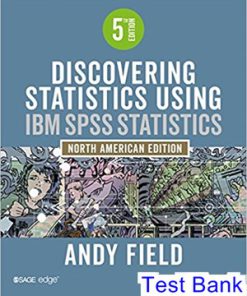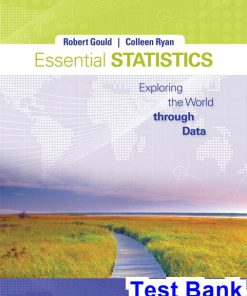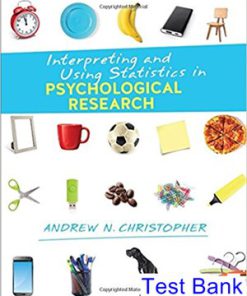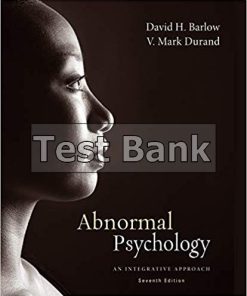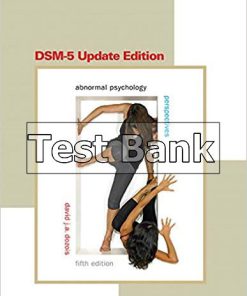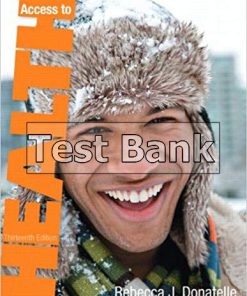Adventure in Statistics 1st Edition Field Test Bank
You may also like
-
$26.50
$50.00
Adventure in Statistics 1st Edition Field Test Bank
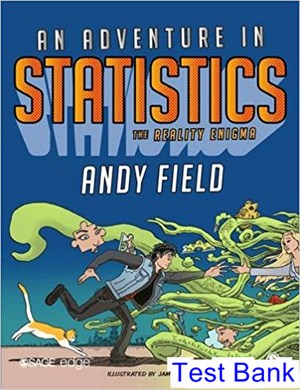
Product details:
- ISBN-10 : 9781446210451
- ISBN-13 : 978-1446210451
- Author: Andy Field
An Adventure in Statistics: The Reality Enigma by best-selling author and award-winning teacher Andy Field offers a better way to learn statistics. It combines rock-solid statistics coverage with compelling visual story-telling to address the conceptual difficulties that students learning statistics for the first time often encounter in introductory courses―guiding students away from rote memorization and toward critical thinking and problem solving.
Field masterfully weaves in a unique, action-packed story starring Zach, a character designed to think like a student who processes information, and the challenges of understanding it, the way a statistics novice would. Illustrated with stunning graphic-novel style art and featuring Socratic dialogue, the story captivates readers as it introduces them to concepts, eliminating potential statistics anxiety.
Table contents:
Prologue: The Dying Stars
1 Why You Need Science: The Beginning and The End 1.1. Will you love me now? 1.2. How science works 1.2.1. The research process 1.2.2. Science as a life skill 1.3. Research methods 1.3.1. Correlational research methods 1.3.2. Experimental research methods 1.3.3. Practice, order and randomization 1.4. Why we need science
2 Reporting Research, Variables and Measurement: Breaking the Law 2.1. Writing up research 2.2. Maths and statistical notation 2.3. Variables and measurement 2.3.1. The conspiracy unfolds 2.3.2. Qualitative and quantitative data 2.3.3. Levels of measurement 2.3.4. Measurement error 2.3.5. Validity and reliability
3 Summarizing Data: She Loves Me Not? 3.1. Frequency distributions 3.1.1. Tabulated frequency distributions 3.1.2. Grouped frequency distributions 3.1.3. Graphical frequency distributions 3.1.4. Idealized distributions 3.1.5. Histograms for nominal and ordinal data 3.2. Throwing Shapes
4 Fitting Models (Central Tendency): Somewhere In The Middle 4.1. Statistical Models 4.1.1. From the dead 4.1.2. Why do we need statistical models? 4.1.3. Sample size 4.1.4. The one and only statistical model 4.2. Central Tendency 4.2.1. The mode 4.2.2. The median 4.2.3. The mean 4.3. The ‘fit’ of the mean: variance 4.3.1. The fit of the mean 4.3.2. Estimating the fit of the mean from a sample 4.3.3. Outliers and variance 4..4. Dispersion 4.4.1. The standard deviation as an indication of dispersion 4.4.2. The range and interquartile range
5 Presenting Data: Aggressive Perfector 5.1. Types of graphs 5.2. Another perfect day 5.3. The art of presenting data 5.3.1. What makes a good graph? 5.3.2. Bar graphs 5.3.3. Line graphs 5.3.4. Boxplots (box-whisker diagrams) 5.3.5. Graphing relationships: the scatterplot 5.3.6. Pie charts
6 Z-Scores: The wolf is loose 6.1. Interpreting raw scores 6.2. Standardizing a score 6.3. Using z-scores to compare distributions 6.4. Using z-scores to compare scores 6.5. Z-scores for samples
7 Probability: The Bridge of Death 7.1. Probability 7.1.1. Classical probability 7.1.2. Empirical probability 7.2. Probability and frequency distributions 7.2.1. The discs of death 7.2.2. Probability density functions 7.2.3. Probability and the normal distribution 7.2.4. The probability of a score greater than x 7.2.5. The probability of a score less than x: The tunnels of death 7.2.6. The probability of a score between two values: The catapults of death 7.3. Conditional probability: Deathscotch
8 Inferential Statistics: Going Beyond the Data 8.1. Estimating parameters 8.2. How well does a sample represent the population? 8.2.1. Sampling distributions 8.2.2. The standard error 8.2.3. The central limit theorem 8.3. Confidence Intervals 8.3.1. Calculating confidence intervals 8.3.2. Calculating other confidence intervals 8.3.3. Confidence intervals in small samples 8.4. Inferential statistics
9 Robust Estimation: Man Without Faith or Trust 9.1. Sources of bias 9.1.1. Extreme scores and non-normal distributions 9.1.2. The mixed normal distribution 9.2. A great mistake 9.3. Reducing bias 9.3.1. Transforming data 9.3.2. Trimming data 9.3.3. M-estimators 9.3.4. Winsorizing 9.3.5. The bootstrap 9.4. A final point about extreme scores
10 Hypothesis Testing: In Reality All is Void 10.1. Null hypothesis significance testing 10.1.1. Types of hypothesis 10.1.2. Fisher’s p-value 10.1.3. The principles of NHST 10.1.4. Test statistics 10.1.5. One- and two-tailed tests 10.1.6. Type I and Type II errors 10.1.7. Inflated error rates 10.1.8. Statistical power 10.1.9. Confidence intervals and statistical significance 10.1.10. Sample size and statistical significance
11 Modern Approaches to Theory Testing: A Careworn Heart 11.1. Problems with NHST 11.1.1. What can you conclude from a ‘significance’ test? 11.1.2. All-or-nothing thinking 11.1.3. NHST is influenced by the intentions of the scientist 11.2. Effect sizes 11.2.1. Cohen’s d 11.2.2. Pearson’s correlation coefficient,r 11.2.3. The odds ratio 11.3. Meta-analysis 11.4. Bayesian approaches 11.4.1. Asking a different question 11.4.2. Bayes’ theorem revisited 11.4.3. Comparing hypothesis 11.4.4. Benefits of bayesian approaches
12 Assumptions: Starblind 12.1. Fitting models: bringing it all together 12.2. Assumptions 12.2.1. Additivity and linearity 12.2.2. Independent errors 12.2.3. Homoscedasticity/ homogeneity of variance 12.2.4. Normally distributed something or other 12.2.5. External variables 12.2.6. Variable types 12.2.7. Multicollinearity 12.2.8. Non-zero variance 12.3. Turning ever towards the sun
13 Relationships: A Stranger’s Grave 13.1. Finding relationships in categorical data 13.1.1. Pearson’s chi-square test 13.1.2. Assumptions 13.1.3. Fisher’s exact test 13.1.4. Yates’s correction 13.1.5. The likelihood ratio (G-test) 13.1.6. Standardized residuals 13.1.7. Calculating an effect size 13.1.8. Using a computer 13.1.9. Bayes factors for contingency tables 13.1.10. Summary 13.2. What evil lay dormant 13.3. Modelling relationships 13.3.1. Covariance 13.3.2. Pearson’s correlation coefficient
14 The General Linear Model: Red Fire Coming Out From His Gills 14.1. The linear model with one predictor 14.1.1. Estimating parameters 14.1.2. Interpreting regression coefficients 14.1.3. Standardized regression coefficients 14.1.4. The standard error of b 14.1.5. Confidence intervals for b 14.1.6. Test statistic for b 14.1.7. Assessing the goodness of fit 14.1.8. Fitting a linear model using a computer 14.1.9. When this fails 14.2. Bias in the linear model 14.3. A general procedure for fitting linear models 14.4. Models with several predictors 14.4.1. The expanded linear model
15 Comparing Two Means: Rock or Bust 15.1. Testing differences between means: The rationale 15.2. Means and the linear model 15.2.1. Estimating the model parameters 15.2.2. How the model works 15.2.3. Testing the model parameters 15.2.4. The independent t-test on a computer 15.2.5. Assumptions of the model 15.3. Everything you believe is wrong 15.4. The paired-samples t-test 15.4.1. The paired-samples t-test on a computer 15.5. Alternative approaches 15.5.1. Effect sizes 15.5.2. Robust tests of two means 15.5.3. Bayes factors for comparing two means
16 Comparing Several Means: Faith in Others 16.1. General procedure for comparing means 16.2. Comparing several means with the linear model 16.2.1. Dummy coding 16.2.2. The F-ratio as a test of means 16.2.3. The total sum of squares (SSt) 16.2.4. The model sum of squares (SSm) 16.2.5. The residual sum of squares (SSr) 16.2.6. Partitioning variance 16.2.7. Mean squares 16.2.8. The F-ratio 16.2.9. Comparing several means using a computer 16.3. Contrast coding 16.3.1. Generating contrasts 16.3.2. Devising weights 16.3.3. Contrasts and the linear model
17 Factorial Designs 17.1. Factorial designs 17.2. General procedure and assumptions 17.3. Analysing factorial designs 17.3.1. Factorial designs and the linear model 17.3.2. The fit of the model 17.3.3. Factorial designs on a computer 17.4. From the pinnacle to the pit 17.5. Alternative approaches 17.5.1. Calculating effect sizes \
People also search:
Download full solution manual at: Adventure in Statistics 1st Edition Field
Download full test bank at: Adventure in Statistics 1st Edition Field
Download full solution manual + test bank at: Adventure in Statistics 1st Edition Field
Download full test bank + solution manual at : Adventure in Statistics 1st Edition Field
Adventure in Statistics 1st Edition Field testbank download pdf
Adventure in Statistics 1st Edition Field download scribd
Adventure in Statistics 1st Edition Field solution manual download pdf

